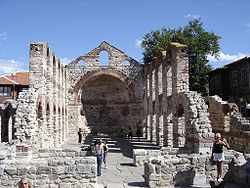- Hagia Sophia Church, Nesebar
-
Saint Sofia Church/The Old Bishopric
Църква Света София/Старата митрополия (Bulgarian)
Basic information Location  Nesebar, Bulgaria
Nesebar, BulgariaGeographic coordinates 42°39′32″N 27°47′10″E / 42.65889°N 27.78611°ECoordinates: 42°39′32″N 27°47′10″E / 42.65889°N 27.78611°E Affiliation Eastern Orthodox Ecclesiastical or organizational status Basilica Architectural description Architectural type Church Completed 5th-6th century Specifications Length 25 metres (82 ft) Width 13 metres (43 ft) Width (nave) 13 metres (43 ft) The Church of Saint Sofia (Bulgarian: Църква Света София), also known as the Old Bishopric (Bulgarian: Старата митрополия) is an Eastern Orthodox church in Nesebar, eastern Bulgaria. It is situated in the old quarter of the town which is part of the UNESCO World Heritage Site list and of the 100 Tourist Sites of Bulgaria.
Contents
History, architectural and artistic features
The church is located in what is supposed to have been the center of the ancient city. It is a three-naved unvaulted basilica with a semi-circular apse, a narthex and an atrium. The church has a total length of 25.5 m and a width of 13 m. The division into three naves was effected by two rows of five pillars each. The middle nave (9.3 m wide) ends to the east with a big closed apse, round outside and three-sided inside. There are three arched windows on the eastern wall above the apse. The basilica used to have a double-sloped roof which has not been preserved. From the inside the church used to be plastered and then painted with frescoes. The whole floor used to be covered with mosaics made out with little coloured stones. It has mixed masonry of stone and brick and is the largest of the Nesebar churches whose overground structure has survived.
The basilica was constructed in the late 5th and early 6th century. Its present appearance was dated from the beginning of the 9th century when it was reconstructed. During the Middle Ages it served as a cathedral for the bishopric eparchy centered in Nesebar. In 1257 the church was looted by the Venetians during a campaign against the Bulgarian Empire and many religious relics were taken in the Church of San Salvatore in Venice. The basilica was abandoned in the 18th century.
Gallery
References
External links
- (Bulgarian) Church of Saint Sofia - Nesebar
- (Bulgarian) The churches of Nesebar
- (Bulgarian) Nesebar - churches and landmarks
Categories:- Churches in Nesebar
- Eastern Orthodox church buildings
- 6th-century church buildings
Wikimedia Foundation. 2010.








